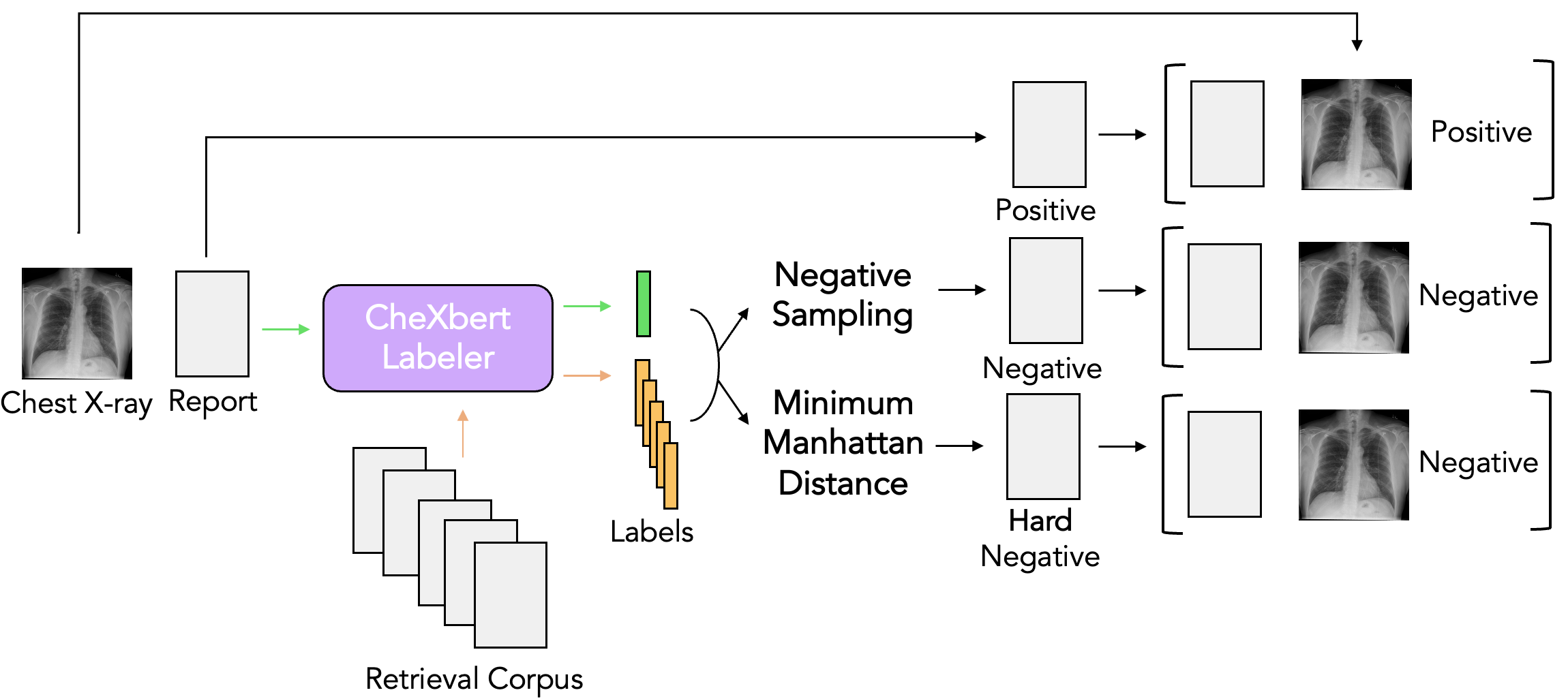This is the offical repository for X-REM (Contrastive X-Ray REport Match), a retrieval-based radiology report generation module that uses learned image-text matching scores as the similarity metric for retrieval. We provide the implementation of X-REM as well as the source code for both training and inference for impression generation.
Dataset generation for Image-Text Matching:
X-REM Training:
X-REM Inference:
Clone X-REM github repo and its submodules:
git clone --recursive https://github.com/rajpurkarlab/X-REM.git
Move the X-REM python scripts to the appropriate folders:
mv M2TransNLI.py m2trans_nli_filter.py ifcc
mv compute_avg_score.py prepare_df.py CXR-Report-Metric
Download our pretrained checkpoints here!
Download the train/test reports and images from MIMIC-CXR. You may have to request for an approval to access the files. mimic_pretrain_study_id.csv and mimic_itm_study_id.csv hold the MIMIC-CXR study ids we used to train our model, and mimic_challenge_dicom_id.csv holds the study id we set aside to use for radiologist evaluation.
Create a conda environment for X-REM:
conda env create -f environment.yml -n X-REM-env
Activate the environment:
conda activate X-REM-env
Refer to the data preprocessing step in CXR-RePaiR to acquire mimic_train_impressions.csv, mimic_test_impressions.csv, and cxr.h5.
Preprocess data to be used for pre-training ALBEF:
python3 -m preprocess_mimic.py --data_dir <path to MIMIC> --impressions_train_path <path to mimic_train_impressions.csv> --impressions_test_path <path to mimic_test_impressions.csv> --out_dir <path to store the processed data>
To pretrain ALBEF, first specify the path to your training dataset in configs/Pretrain.yaml and run:
cd X-REM
python3 -m torch.distributed.launch --nproc_per_node=4 --use_env Pretrain.py --config configs/Pretrain.yaml --output_dir <output path> --checkpoint <path to ALBEF_4M.pth> --resume true
Generate train files for image-text matching task:
python generate_itm_train.py
Finetune the ALBEF model on image-text matching task:
cd X-REM
python3 -m torch.distributed.launch --nproc_per_node=4 --use_env ITM.py --config ./configs/ITM.yaml --output_dir <output path> --checkpoint <path to pre-trained checkpoint>
Move to the X-REM directory:
cd X-REM
Create the datasets to be used for inference. Use the cxr.h5 and mimic_train_impressions.csv created during the preprocessing step.
Note that the input dimension is 256 * 256 pixels for the pre-trained ALBEF and 384 * 384 for the fine-tuned ALBEF.
import pandas as pd
from XREM_dataset import CXRTestDataset_h5
dset_cosine = CXRTestDataset_h5(<path to cxr.h5>, 256)
dset_itm = CXRTestDataset_h5(<path to cxr.h5>, 384)
train_data = pd.read_csv(<path to mimic_train_impressions.csv>)
reports = train_data["report"].drop_duplicates().dropna().reset_index(drop = True)
Initialize the config file by specifying the path to the trained checkpoints as well as their config files:
from XREM_config import XREMConfig
config = XREMConfig(
albef_retrieval_config = <path to the pre-trained ALBEF config>,
albef_retrieval_ckpt = <path to the pre-trained ALBEF checkpoint>,
albef_itm_config = <path to the fine-tuned ALBEF config>,
albef_itm_ckpt = <path to the fine-tuned ALBEF checkpoint>,
)
Initialize the model with the trained weights and perform inference:
from XREM import XREM
xrem = XREM(config)
itm_output = xrem(reports, dset_cosine, dset_itm)
Save the output as a pandas datframe:
itm_df = pd.DataFrame(itm_output, columns = ['Report Impression'])
itm_df.to_csv(<preliminary save path>, index = False)
Post-process the result using a NLI filter:
cd ../ifcc
conda activate m2trans
python3 m2trans_nli_filter.py --input_path <preliminary save path> --save_path <final save path>
conda deactivate
cd CXR-Report-Metric
conda activate <environment name for CXR-Report-Metric>
python prepare_df.py --fpath <input path> --opath <output path>
python test_metric.py
python3 compute_avg_score.py --fpath <input path>
Refer to CXR-Report-Metric for a detailed explanation on the metric.
- To generate reports with varying top-k values, repeat the previous step with the following config file:
config.albef_retrieval_top_k = <num reports retrieved with cosine sim>
config.albef_itm_top_k = <num reports retrieved with image-text matching scores>
- To generate reports without using the image-text matching scores, initialize the model with the following config file:
config.albef_retrieval_top_k = 2
config.albef_retrieval_delimiter = ' '
config.albef_itm_top_k = 0
- To generate reports without the nli filter, initialize the model with the following config file:
config.albef_itm_delimiter = ' '
config.albef_itm_top_k = 1
- To replace the nli filter with bertscore as the metric for measuring redundancy, run the following command instead of
m2trans_nli_filter.py:
cd X-REM
python3 bertscore_filter.py --input_path <preliminary save path> --save_path <final save path>
- To skip the pre-training step and directly fine-tune the off-the-shelf ALBEF checkpoint on image-text matching, re-train the model:
cd X-REM
python3 -m torch.distributed.launch --nproc_per_node=4 --use_env ITM.py --config ./configs/ITM.yaml --output_dir <output path> --checkpoint <path to ALBEF_4M.pth>
Then, initialize the config file with albef_retrieval_ckpt = <path to ALBEF_4M.pth> and albef_itm_ckpt = <output path> .
Feel free to contact Jaehwan Jeong (jaehwanj@stanford.edu) regarding any questions regarding the code or our paper.
Jeong, J., Tian, K. et al. Multimodal Image-Text Matching Improves Retrieval-based Chest X-Ray Report Generation. Medical Imaging with Deep Learning (2023)


